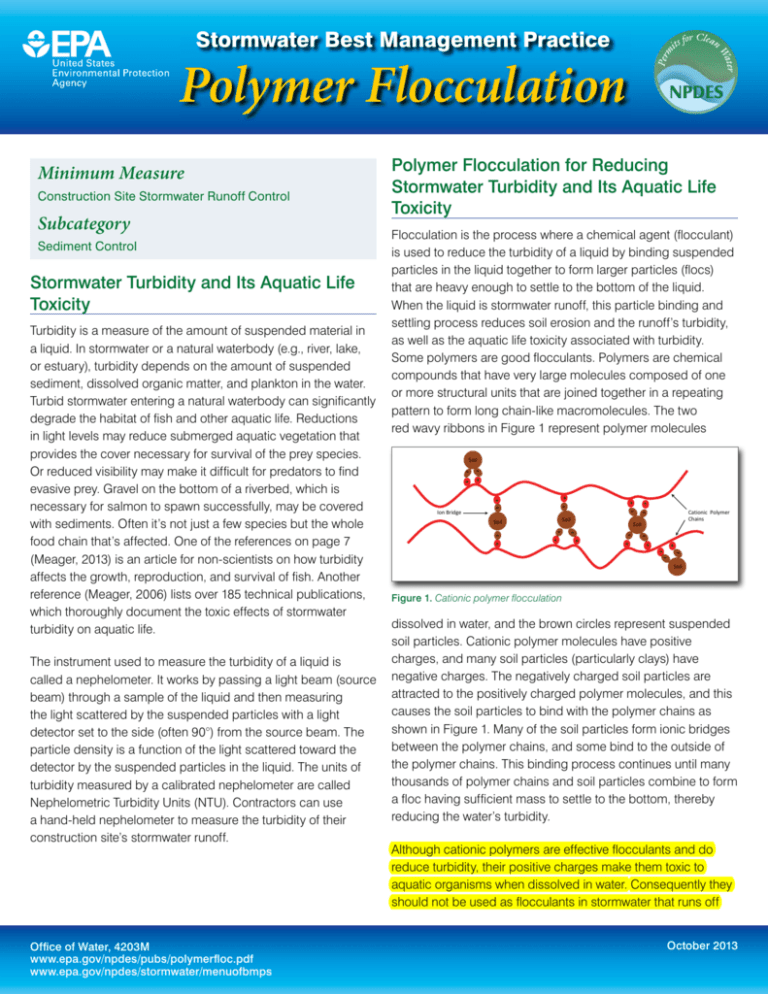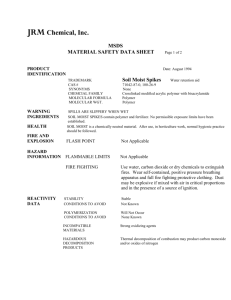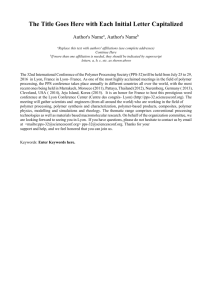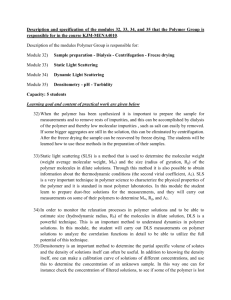EPA Flocculant Handout - Applied Polymer Systems
advertisement

Stormwater Best Management Practice Polymer Flocculation Minimum Measure Construction Site Stormwater Runoff Control Subcategory Sediment Control Stormwater Turbidity and Its Aquatic Life Toxicity Turbidity is a measure of the amount of suspended material in a liquid. In stormwater or a natural waterbody (e.g., river, lake, or estuary), turbidity depends on the amount of suspended sediment, dissolved organic matter, and plankton in the water. Turbid stormwater entering a natural waterbody can significantly degrade the habitat of fish and other aquatic life. Reductions in light levels may reduce submerged aquatic vegetation that provides the cover necessary for survival of the prey species. Or reduced visibility may make it difficult for predators to find evasive prey. Gravel on the bottom of a riverbed, which is necessary for salmon to spawn successfully, may be covered with sediments. Often it’s not just a few species but the whole food chain that’s affected. One of the references on page 7 (Meager, 2013) is an article for non-scientists on how turbidity affects the growth, reproduction, and survival of fish. Another reference (Meager, 2006) lists over 185 technical publications, which thoroughly document the toxic effects of stormwater turbidity on aquatic life. The instrument used to measure the turbidity of a liquid is called a nephelometer. It works by passing a light beam (source beam) through a sample of the liquid and then measuring the light scattered by the suspended particles with a light detector set to the side (often 90°) from the source beam. The particle density is a function of the light scattered toward the detector by the suspended particles in the liquid. The units of turbidity measured by a calibrated nephelometer are called Nephelometric Turbidity Units (NTU). Contractors can use a hand-held nephelometer to measure the turbidity of their construction site’s stormwater runoff. Office of Water, 4203M www.epa.gov/npdes/pubs/polymerfloc.pdf www.epa.gov/npdes/stormwater/menuofbmps Polymer Flocculation for Reducing Stormwater Turbidity and Its Aquatic Life Toxicity Flocculation is the process where a chemical agent (flocculant) is used to reduce the turbidity of a liquid by binding suspended particles in the liquid together to form larger particles (flocs) that are heavy enough to settle to the bottom of the liquid. When the liquid is stormwater runoff, this particle binding and settling process reduces soil erosion and the runoff’s turbidity, as well as the aquatic life toxicity associated with turbidity. Some polymers are good flocculants. Polymers are chemical compounds that have very large molecules composed of one or more structural units that are joined together in a repeating pattern to form long chain-like macromolecules. The two red wavy ribbons in Figure 1 represent polymer molecules Soil - + + + + Ion Bridge - + - + - - Soil Soil + + - - - Cationic Polymer Chains Soil + + + + + - - Soil Figure 1. Cationic polymer flocculation dissolved in water, and the brown circles represent suspended soil particles. Cationic polymer molecules have positive charges, and many soil particles (particularly clays) have negative charges. The negatively charged soil particles are attracted to the positively charged polymer molecules, and this causes the soil particles to bind with the polymer chains as shown in Figure 1. Many of the soil particles form ionic bridges between the polymer chains, and some bind to the outside of the polymer chains. This binding process continues until many thousands of polymer chains and soil particles combine to form a floc having sufficient mass to settle to the bottom, thereby reducing the water’s turbidity. Although cationic polymers are effective flocculants and do reduce turbidity, their positive charges make them toxic to aquatic organisms when dissolved in water. Consequently they should not be used as flocculants in stormwater that runs off October 2013 Stormwater Best Management Practice: Polymer Flocculation the land into natural waterbodies. However, anionic polymers, which carry a negative charge, are not toxic. If they’re added to stormwater along with some positive ions, the soil particles will bind onto these anionic polymer molecules and form the ionic bridges shown in Figure 2. Adding positive calcium ions (Ca++) to the anionic polymer enables anionic polymer flocculation, which can reduce the turbidity without harming the aquatic life. Ca++ Positive Ion Ca++ -Soil Ca ++ Ionic Bridge - Ca++ Soil Ca - - Ca++ Ca++ ++ Soil - - - Ca++ Ca++ Anionic Polymer Ca Chains - Soil - Ca Ca - - - -Ca Ca - Soil- Ca++ ++ ++ ++ ++ ++ Figure 2. Anionic polymer flocculation Floc collection becomes important if the stormwater runoff velocity is too high to allow the flocs to settle to the bottom. In these cases an attachment surface, such as the soft matting (jute, hemp, burlap, or coconut coir) Figure 3. Matting used for floc collection shown in Figure 3, needs to be installed across the flow to collect the flocs. Polymer flocculation is based on three fundamental processes: chemical binding, settling, and floc collection. Polymer Flocculation BMPs Polymer flocculation provides the basis for a number of best management practices (BMPs) for reducing stormwater turbidity and its toxicity. Flocculants can be applied directly to: the soil surface, water flowing in a channel, a natural waterbody, or a settling pond. Examples of these four basic types of BMP applications are described below. One of them alone may be sufficient for a relatively simple project, or several of these BMPs may be used together to design a polymer flocculation system for a larger project. Soil Surface Applications—3 examples Soil stabilization. The objective is to bind soil particles together so they become more resistant to the erosive forces of wind or water and to promote revegetation following a soil disturbing activity such as construction. Soft matting can be applied over the ground (Figure 4) to provide an attachment surface for floc collection as runoff Figure 4. Slope covered with floc flows down the slope. If collection matting hydroseeding is used, the addition of a polymer flocculant in liquid form to the hydroseeding mix will bind the seed, fertilizer, and other additives to the soil until the new vegetation is established. The hydroseeding mix is Figure 5. Hydroseeding the slope then sprayed on the slope (Figure 5), and vegetation is established to stabilize the slope (Figure 6). When hydroseeding is not used, the powdered polymer can be applied by hand over the matting. When it rains, the powdered polymer dissolves and Figure 6. Stabilization four weeks later the soil particles become chemically bound to the long polymer molecules. The resulting flocs are sticky and adhere to the fibers of the soft matting to create a highly erosion resistant surface that supports vegetation. If straw or mulch is used instead of soft matting to cover the ground, the flocs will also adhere to either of them and provide good erosion resistance and revegetation support. Dispersion fields. The objective is to reduce the velocity, erosive force, and turbidity of rapidly flowing water by allowing it to spread out over a relatively level area. Checks or wattles can be placed perpendicular to the flow to reduce its velocity. Soft matting installed over the dispersion field and covered with a polymer powder will reduce the water’s turbidity by binding the suspended particles together so they form particulate-polymer agglomerations that settle and adhere to the jute matting. When wells are drilled during home construction to provide drinking water or geothermal water for heating and air Stormwater Best Management Practice: Polymer Flocculation flocculation and particle collection in the dispersion field and a sediment retention barrier, the turbidity was only 21 NTUs. conditioning systems, the water discharged from the drilling operations can be laden with rock chips and sediment and is often toxic. A drilling rig and its settling pit that allows larger particles from the rig’s discharge Figure 7. Drilling rig and settling pit to settle out is shown in Figure 7. The water then flows through a flocculation ditch and a small dispersion field, which is lined with jute matting covered with polymer flocculant powder to clarify the water before it’s discharged. The turbidity of water coming from the drilling rig was over 5,000 NTU. But after the settling pit and polymer flocculation in the mixing ditch and dispersion field, the discharged water’s turbidity was reduced to 2 NTU. Dust control. The objective of dust control is to reduce airborne dust from haul roads, tailings piles, waste dumps, and open areas on construction sites. The polymer is mixed and dissolved in water and then sprayed directly on the road Figure 11. Water truck applying dissolved polymer flocculant or other ground surface (Figure 11). A comparison of construction site road dust before and after polymer flocculation is shown in Figures 12 and 13. Using a flocculant to bind the dust particles will also reduce the amount of water needed to spray dusty construction areas. A much larger dispersion field was needed to clarify the spoils from a dredging operation before they were discharged back into a Tennessee Valley Authority lake. The dredge spoils were initially pumped into a settling pond to allow the heaver particles to settle. Then after passing through the mixing ditch in Figure 8, they entered an 8,100 square foot dispersion Figure 8. Large mixing ditch field (Figure 9) lined with jute matting, which was covered with a powdered polymer flocculant. After passing over a dispersion field and through a sediment retention barrier, the clarified water was Figure 9. Dispersion field with jute returned to Kentucky matting and flocculant powder Lake (Figure 10). The dredge spoils pumped into the settling pond were 15% solids. After settling, the water discharged from the settling pond had a turbidity ranging from 500 to 600 NTUs. And after flocculation in the treatment Figure 10. Clarified dredge spoils returning back to the lake ditch followed by additional Figure 12. Road dust before applying polymer flocculant Figure 13. Road dust after applying polymer flocculant Channel Applications—4 examples Treatment ditches. When a construction site sediment basin like the one in Figure 14 needs to be dewatered, an aboveground treatment ditch built of hay bales covered with plastic can be used to reduce the water’s turbidity before it’s discharged to the environment. Soluble polymer blocks are tethered along the higher portion of the ditch, and particle collection matting covers the bottom of the ditch along its lower portion (Figure 15). When water is released from the settling 3 Figure 14. Sediment basin to be dewatered Figure 15. Lower portion of the treatment ditch Stormwater Best Management Practice: Polymer Flocculation Closed pipes. The construction site for a large number of homes near Disney World was drained because it was originally marsh land. The contractor pumped the water over a quarter of a mile through closed Figure 19. Polymer blocks inserted into pipes to a natural lake. pipes To prevent the lake from becoming turbid, soluble polymer blocks were inserted through holes that were cut along the top of the pipes and anchored in place (Figure 19). Polymer flocculation within the pipes bound suspended sediment particles in the water together, so they had sufficient mass to settle before discharged into the lake, rather than increase the lake’s turbidity. Water leaving this construction site had a turbidity of about 8,000 NTU, but after flocculation the water discharged to the lake measured about 10 NTU. basin and flows through the upper part of the treatment ditch over and around the blocks, the polymer blocks begin to dissolve, turbulence causes mixing, and the sediment particles suspended in the water bind with polymer molecules to form flocs. When these flocs reach the lower and wider portion of the ditch, the water velocity is reduced and the flocs settle to the bottom and adhere to the soft matting. After this flocculation and particle collection, the clarified water is discharged. A larger above ground treatment ditch with a 3,500 gallons per minute flow was previously shown in Figure 8. Treatment ditches can also be dug into the ground. A treatment ditch in Figure 16 has checks placed perpendicular to the flow to increase polymer mixing. This flocculation ditch reduced the turbidity of water from a phosphate mining operation from 1,500 NTU to 25 NTU, which meets Florida’s turbidity standard. Figure 16. Flocculation ditch with checks to increase the polymer mixing Split pipes. A sediment pond at a construction site was dewatered using split pipe sections joined together. The pipe’s upper sections contained soluble polymer blocks (Figure 20) and its lower sections were lined with soft matting to collect the flocs (Figure 21). The treatment ditch used to clarify stormwater runoff from a highway construction site (Figure 17) has deeply corrugated sides that Figure 17. HDPE treatment ditch liner create turbulence which facilitates flocculation by mixing the polymer flocculant with the turbid stormwater. The ditch is made of high density polyethylene (HDPE) sections that can be disassembled and reused on other projects or recycled. These sections eliminate the need for the hay bales and plastic linings, they reduce the amount of construction material taken to municipal landfills for disposal, they will stack tightly for Figure 18. In-ground treatment transporting to another job site ditch or storage, and they can also be used to line in-ground treatment ditches (Figure 18). They’re a green product made of about 75% recycled material. Figure 20. Split pipe with polymer blocks Figure 21. Split pipe with soft matting Irrigation furrows. Applying polyacrylamide (PAM) to irrigation furrows improves the irrigation process by providing more water to the crops. As water flows down the furrow it infiltrates through pores in the sides and bottom of the furrow and into the surrounding soil. PAM binds the fine soil particles into aggregates (flocs), which are too large to clog these pores, and this increases the infiltration. Maintaining larger pores provides more water to the crops because infiltration rate increases exponentially with the diameter of the furrow’s pores. The water 4 Stormwater Best Management Practice: Polymer Flocculation to be replaced during a fall salmon run. Before this construction project began, water soluble, polymer flocculant blocks were placed in the river 20 to 30 feet downstream of the culvert (Figure 25) to protect the spawning ground from turbidity. Jute matting was Figure 25. Six of the polymer blocks placed downstream placed downstream of the polymer blocks (Figure 26) to collect the flocculated soil particles. Before the old culvert could be removed, a channel had to be dug to divert the flow around the construction site. The diversion channel was lined with plastic Figure 26. One of the in situ jute particle and crushed limestone, collection mats which was covered with polymer powder to prevent white plumes of lime sediment from drifting downstream. This flocculation successfully clarified the water in the diversion channel and in the river below the construction Figure 27. Salmon smolt swimming in the diversion ditch site. Little salmon smolts (Figure 27) as well as spawning adults could be seen swimming in these waters. To protect the habitat, it was important to have this flocculation system in place before the construction project began. is then delivered to the crops by a soil water pressure gradient, which is greatest by the wetted furrow and then decreases toward the crop roots as water is taken up by the roots due to the plants’ transpiration. Polymer flocculation also reduces irrigation-induced erosion and sediment transport. The binding of polymers to furrow soils increases the soil aggregate cohesion, prevents aggregates on the bottom of a furrow from breaking up, and helps preserve the furrow’s roughness. In addition, PAM flocculates fine soil particles that may become suspended in the furrow stream. The resulting large flocs are less likely to seal soil pores and reduce infiltration. The polymer’s combined effects on furrow roughness and infiltration reduce the furrow’s erosion and sediment transport. Figure 22 shows a furrow treated with PAM having little erosion and clear water. Figure 23 shows an untreated furrow having erosion and cloudy water. Imhoff cones in Figure 24 compare the turbidity in these two furrows. The cone on the left holds water from the furrow treated with PAM; the cone on the Figure 22. Furrow treated with PAM right holds water from the untreated furrow. Figure 23. Untreated furrow with erosion Figure 24. Comparison of water from furrows with and without PAM Natural Waterbody (in situ) Applications—4 examples Salmon spawning habitat. The Anna River in Michigan’s Upper Peninsula is good Coho Salmon spawning habitat. An old rusty culvert under a road that crosses over the river was scheduled Figure 28. Three in-stream baskets 5 In-stream baskets. The baskets in Figure 28 introduce soluble polymer blocks to turbid water down stream of construction work. This allows the dissolved polymer to mix with the turbid water and facilitates the binding reaction between polymer molecules and suspended particles, which reduces turbidity. Stormwater Best Management Practice: Polymer Flocculation Particle curtains. After suspended sediment particles are bound to the flocculant in flowing waters, if the velocity is too high to allow the flocs to settle to the bottom, then particle curtains of jute or other soft matting can be suspended from floats across the current, to collect the flocculated particles. However, particle curtains are not a stand-alone BMP. They must be placed just downstream of a polymer flocculation system. The particle curtain shown in Figure 29 is being lowered into a canal in central Florida. Three particle curtains in Figure 30 are placed across the inflow to a pond. Each curtain reduces the inflow’s turbidity. Figure 29. Particle curtain in a canal Figure 31. Newly constructed water garden Settling Pond Applications— 2 examples Figure 32. Polymer flocculant logs placed in the waterfall Figure 35. Clarified discharge water near the end of the treatment ditch particles. Jute matting covered with powdered polyacrylamide flocculant placed under the sediment bag and along its discharge ditch (Figure 34) will clarify the discharge water by flocculating the fine sediment particles that pass through the bag and binding them to the soft matting. The discharged water in Figure 35 is much less turbid than the water leaving the sediment bag. Sediment removal. The highly saturated sediment remaining in a sediment basin after it has been dewatered is often difficult to remove. Mixing the granular form of PAM into this sediment will bind the particles together and stiffen it, making it easier to remove (Figure 36). This is done by spreading the granular PAM flocculant evenly over the sediment surface and then mixing it into the top three feet Figure 36. Removing stiffened sediment of sediment using the from a sediment basin excavator equipment’s bucket. Do not dump the flocculant in a pile. If the sediment is deeper than three feet, this mixing and removal can be repeated for each successive threefoot layer of sediment. The sediments removed may Figure 37. Recycling sediment along a be recycled as topsoil highway (Figure 37). Figure 30. Particle curtains clarifying the input to a pond Waterfall mixing system. A water garden landscape in Atlanta was quite turbid after its construction (Figure 31). Polymer logs were placed in the waterfall (Figure 32), which provided mixing of the dissolved polymer molecules and suspended sediment particles. After 24 hours the turbidity was significantly reduced, and after 48 hours coi (ornamental carp) could inhabit the pond (Figure 33). Dewatering sediment basins. When settling ponds or basins need to be dewatered, the water can be pumped through a sediment bag, which traps the coarse sediment Figure 34. Sediment bag and its treatment ditch Figure 33. Coi pond two days later 6 Stormwater Best Management Practice: Polymer Flocculation Polymer Flocculation Systems Composed of Multiple BMPs Working Together—1 example References Applied Polymer Systems Inc. 2011. Polymer Enhanced Best Management Practice (PEBMP) Application Guide. Woodstock, GA. www.siltstop.com/pdf/PEBMPJune2013.pdf At an office construction site in Tennessee, a powdered polymer was applied directly to stabilize the soil surface in gullies (Figure 38) draining to a sediment pond at the lower portion of the site. Soluble polymer blocks were tethered inside a closed pipe (culvert) running under a construction road (Figure 39) that also drained to the pond. Before these BMPs were installed, the sediment pond was quite turbid (Figure 40). Two Figure 38. Eroding gully on a weeks after their installation construction site and several significant rain events, the pond was clear, and only the sediment deltas remained (Figure 41). Designing polymer flocculation systems often involves using multiple BMPs and having them work well together. Meager, Justin 2006. Turbidity and Fish Behavior List of References. www.justin-meager.com/turbidity_references.htm Meager, Justin 2013. Turbidity and Fish Behavior. www.justin-meager.com/turbid.htm Toronto and Regional Conservation Authority 2013. Anionic Polyacrylamide Application Guide for Urban Construction in Ontario. USDA, Natural Resources Conservation Service 2002. Conservation Practice Standard: Anionic Polyacrylamide Application, Code 450. http://efotg.sc.egov.usda.gov/ references/public/NM/450STD-2011June.pdf Photograph Credits Figures 1, 2. King Boynton, U. S. EPA, Office of Water Figures 3 – 10. Steve Iwinski, Applied Polymer Systems, Inc. Figures 11 – 13. Eddie Snell, Reedy Creek Improvement District, Lake Buena Vista, Florida Figures 14 – 16. Steve Iwinski, Applied Polymer Systems, Inc. Figure 39. Polymer block in a construction site culvert Figure 17. Eddie Snell, Reedy Creek Improvement District, Lake Buena Vista, Florida Figures 18. Mark Maederer, Penda Corporation Figures 19. Eddie Snell, Reedy Creek Improvement District, Lake Buena Vista, Florida Figures 20 – 21. Steve Iwinski, Applied Polymer Systems, Inc. Figures 22 – 24. Website, USDA, Agricultural Research Service Figures 25 – 28. Steve Iwinski, Applied Polymer Systems, Inc. Figure 40. Sediment pond before BMPs were installed Figure 29. Eddie Snell, Reedy Creek Improvement District, Lake Buena Vista, Florida Figure 41. Same pond after BMPs were installed Figures 30 – 41. Steve Iwinski, Applied Polymer Systems, Inc. Site-Specific Performance Testing The effectiveness of polymer flocculation depends on the sitespecific soil characteristics and the particular polymer used. There are hundreds of anionic polymers, and they’re not all an effective flocculant for a particular soil. Sometimes a blend of polymers provides the most effective flocculation. A performance ratio of 95% (the amount of polymer attaching to soil particles) is considered a very effective flocculant. Increasing the flocculant application rate will not necessarily result in better performance. Site-specific soil sampling and analysis are recommended to determine the reaction time and most effective polymer blend. Disclaimer Please note that EPA has provided external links because they provide additional information that may be useful or interesting. EPA cannot attest to the accuracy of non-EPA information provided by these third-party websites and does not endorse any non-government organizations or their products or services. 7









